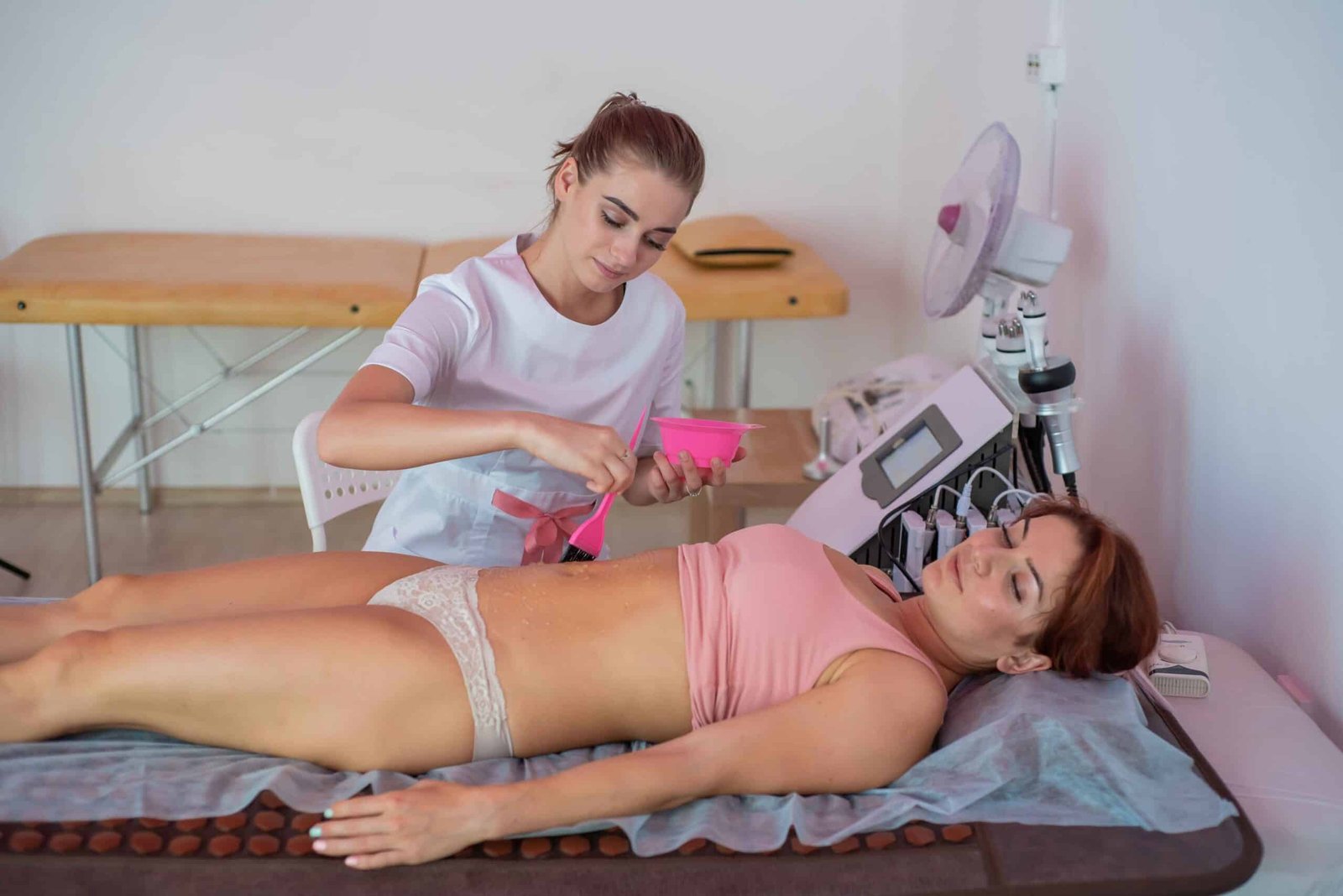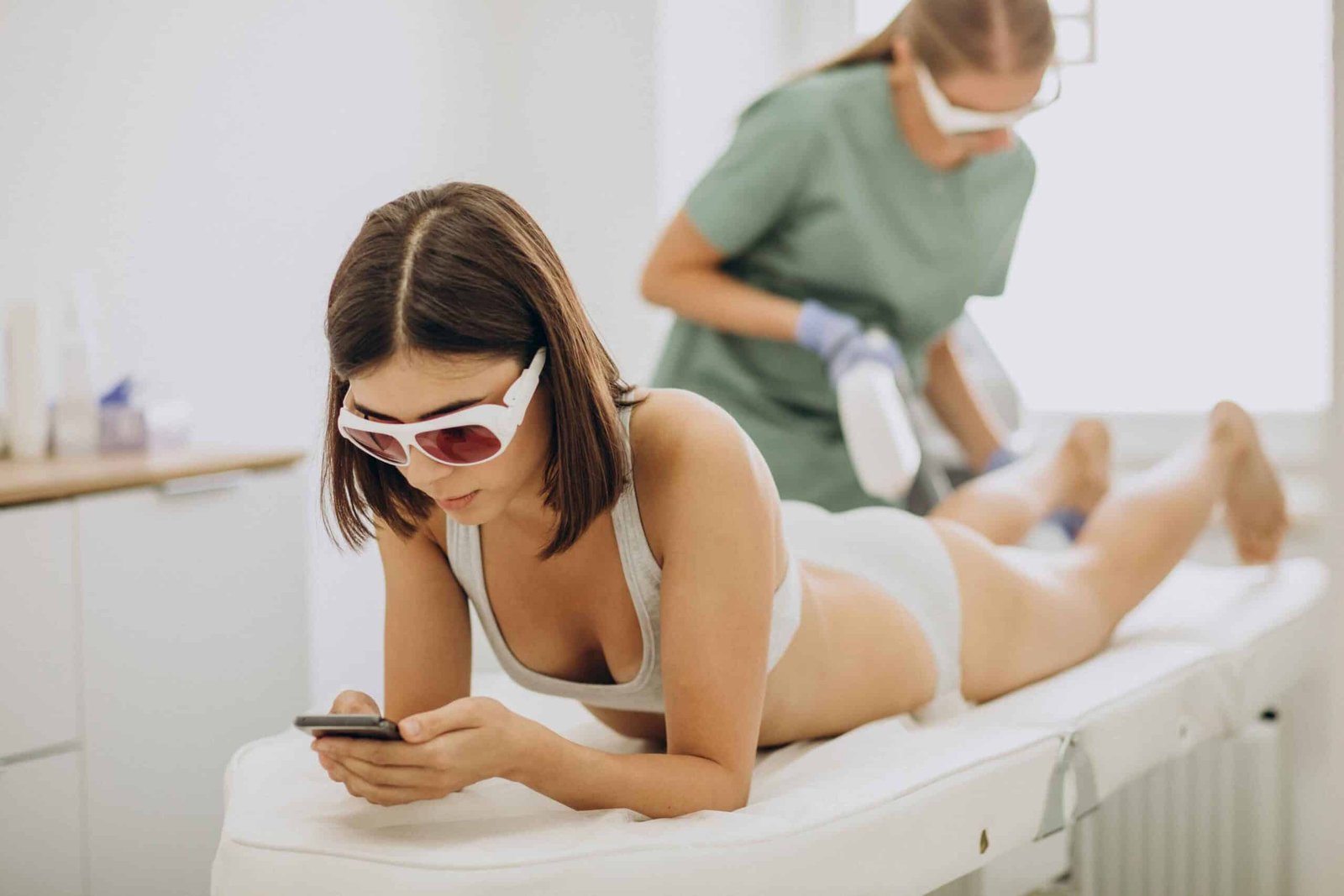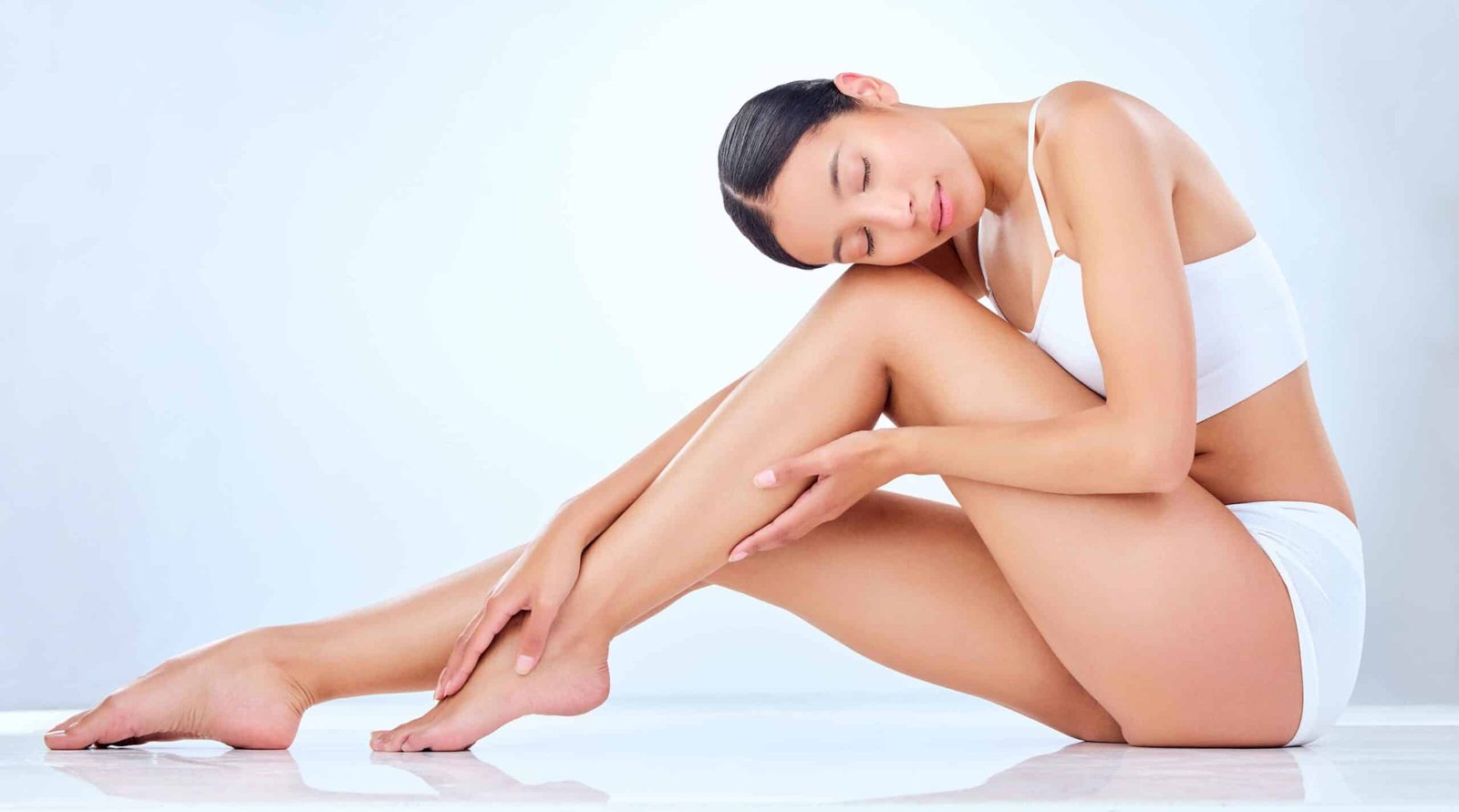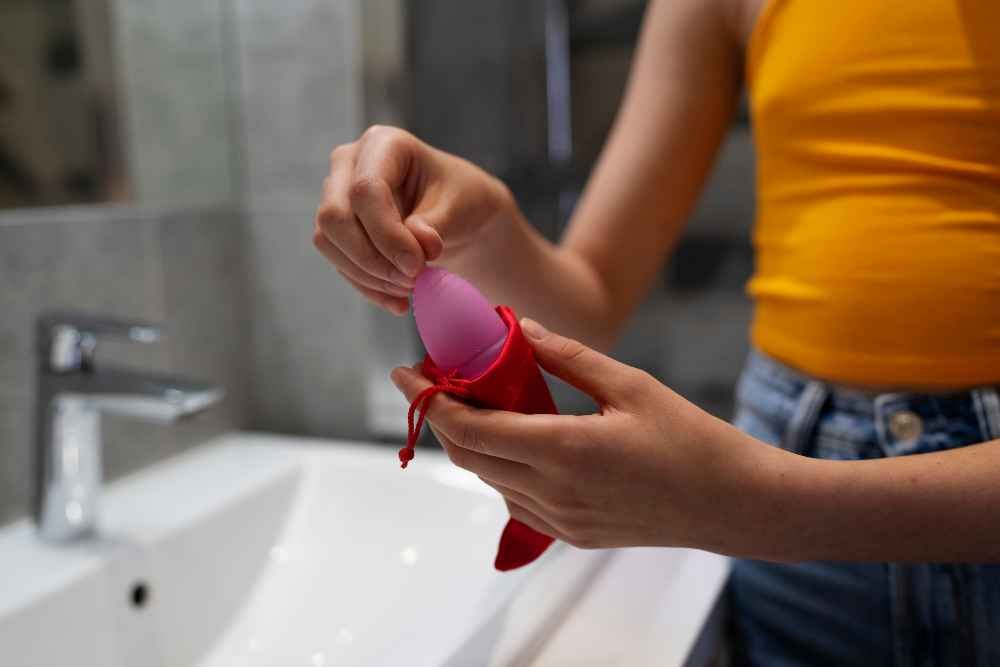A bikini wax is a waxing technique that involves the removal of pubic hair on the bikini area. Like any other waxing process, it entails applying hot wax to a designated area, which is subsequently torn off to pull the hair from its roots.
Whether you are a beginner or have already done your waxing, being curious about bikini wax after 2 weeks is normal. Two weeks after the application, new hairs will grow, and fresh outgrowths will appear in other regions too. Ultimately, the hair will become fazed out and with constant waxing, the intervals will widen and density will reduce.
But there is more to know about what you can expect. So, let’s dive into the details!
What Is Bikini Waxing?

Bikini waxing is a hair removal technique that uses warm wax for the bikini area of your body. Once the area that needs waxing is ready, the technician applies wax and later places cloth strips over the wax so that it cools down.
Waxing works by attaching to the hair and when pulled off, the hair is ripped from the root. This method is less painful than other methods, while also leaving the skin smooth and hairless for a longer time than shaving. This method is great for keeping the bikini area well-groomed for hygiene purposes.
The procedure starts with your aesthetician waxing a section of your bikini line. Next, the aesthetician tears a cloth strip that was placed over the wax to remove it.
This technique yanks hair out from the root and has a cooling effect on the skin. Some patients feel a little burning sensation, but the pain is short-lived, and many people find the discomfort worth it for longer-lasting results.
People have different concepts of bikini waxing which is categorized into waxing done around the bikini line, Brazilian waxing, and Hollywood waxing.
One of the major advantages of bikini waxing is that it does not result in unwanted hair regrowth compared to shaving. As the hair is plucked out from the root, it will take a longer time until it begins to sprout again.
The Different Types of Bikini Waxes

As far as bikini styles are concerned, one can get several styles done ranging from the softest to the most extreme. If you are waxing for the first time, you may find it quite challenging to determine which type of waxing style would suit you the best. But do not worry! There is something for everyone out there.
Basic Bikini Wax

This type of wax style is perfect for those who only wish to clean up around the bikini line and not go overboard. The waxing procedure takes off hair to the right and left up to one hand span from the thighs down and around the stomach.
This ensures a clean shape and also guarantees that no hair emerges from one’s swimsuit or underwear. Do not worry, with the Basic bikini wax you will find yourself feeling clean without feeling underdressed.
French Bikini Wax

A French bikini wax leaves you with more hair than the standard wax would leave you with. Most of the sides and the front are taken off leaving the private area untouched. It’s ideal for women who want a smooth look without feeling fully naked.
Women often opt for some hair left in the front to be shaped into tiny landing strips. If you want something more unique, for example, a triangle shape, you are free to ask for it.
Brazilian Bikini Wax

Brazilian bikini wax removes nearly all hair from the sides, back, and front, leaving only restricted areas on the pubic bone. If you want to go bald, this is your best option. Don’t be afraid to try something new.
It might seem like a scary option for first-timers, but it is extremely effective and if you want a clean and maintained look, this is for you. Eventually, the hair will regrow thinner, providing smoother skin for longer.
Full Bikini Wax

Some don’t mind ‘going all the way’ while others love keeping things a little more than basic. The ‘full bikini wax’ is best suited for those individuals. This type of waxing reduces shaving in and around the pubic region which makes one look neat and natural at the same time.
The primary goal is to define the bikini area but some hair is left untouched. In fact, most salons refer to this style as a “standard bikini line.”
For those doing bikini waxing for the first time, this option is more comfortable as you can keep your underwear on during the procedure.
What Happens to Your Skin After a Bikini Wax?

After undergoing a procedure like waxing, one can have sensitive skin and feel itchy. Waxing is known to yank hair from its roots and this leaves skin prone to irritation thus making it sensitive.
Keeping a close track of the sensations – a little redness, swelling or tingling post-treatment – is well advised. Waxing is in fact an invasive treatment and one can expect these reactions as normal.
After doing the procedure, it is crucial to take care of the skin to further avoid irritation and assist with the healing process.
This irritation is most often experienced right after waxing and should resolve quickly with some care. During puberty, youth experience skin sensitivity due to exposed hair follicles, which is worsened when the hair is overly plucked.
Follicles become inflamed which is why one should avoid using tight clothes that constrict areas around skin as well as excessive rubbing of the area. Soothing lotions and cooling gels could also provide relief to a certain point.
While skin is observed healing, you may start noticing bumps or ingrown hair as well. Don’t be alarmed, as this is completely normal and will subside as the hair grows and in no time.
Will A Bikini Wax Last 2 Weeks?

Bikini wax usually takes somewhere around three to six weeks to heal, anything over that is generally termed as slow aftercare healing. Bikini waxing is an outlier as compared to shaving since it has a longer duration.
You should start noticing some subtle hair regrowth after two weeks. Regular bikini waxes slow down hair regrowth and can, over time, result in decreased hair density. To get the best results, it is recommended that bikini waxes be administered every 3 to 4 weeks.
Because hair growth patterns and speed vary from person to person, there is no universally accepted time frame. Most people do, however, start to notice hair regrowth around the three-week mark.
For people who experience prolonged hair regrowth, you would likely benefit from scheduling an appointment after four to five weeks. If waxing your underarms and bikini area, you will notice that your appointments are more frequent, but as you continue to wax, the intervals are more spaced out.
What Impacts The Longevity Of Bikini Wax?
Numerous variables can determine how often you must schedule your bikini wax. Because everyone’s skin and hair are unique, the outcome is always different. If you know how to work with these factors, you can always look your best.
Hair Type
Your hair texture also has an important influence on the bikini wax duration. If you have dense and coarse hair, you are most likely to have a lot of hair growth.
Higher-quality hair is usually more coarse which means that it will outgrow its current phase quicker than inferior strands. Meanwhile, people with fine hair have a better chance of seeing longer waxing periods.
The type of hair you have affects the waxing experience and how often you’ll need to return for touch-ups.
Rate Of Hair Growth
Your particular hair growth rate is of equal importance. Normally, hair grows at a rate of 1/4 inch a month. But like many other aspects, it can differ from one person to another.
As an example, some tend to have hair that grows at a quicker rate while for others, regrowth is comparatively slower. Knowing your hair growth cycle can assist you with timing your next waxing appointment.
Waxing every few weeks can help ensure the hair doesn’t get too long between sessions. If you tend to grow hair at a slower rate in between wax sessions, you might want to schedule them further apart.
The Phases Of Hair Growth
Hair grows in cycles; anagen (growth), catagen (rest), and telogen (fallout). The first phase of the cycle is where the hair is actively growing and is known as the anagen phase.
Waxing at this time proves to be the most effective. In fact, as hair moves through these phases, you may see a variation in the regrowth process. Faster hair growers will likely notice a faster regrowth cycle while others may experience a more dormant phase.
When you decide to wax, and how aligned your hair is to this cycle will affect how long the results will last.
Essence Skincare Routine
The care given to the skin after waxing plays an important role in how long the smooth skin lasts. Sometimes if the skin is not taken care of properly, there can be issues of ingrown hair and skin irritation due to which the hair may grow back sooner.
Maintaining proper skin care is equally important incorporating gentle exfoliation and good moisturizing. Using gentle skincare products can also help extend the duration between waxing sessions.
This also allows for the healing of the skin by preventing inflammation and helps in keeping the pores clean.
Frequency of Waxing
Moving on, the frequency of waxing has an impact on the degree of results obtained as well. Thin, weak hair follicles are easier to wax off, so over time, when waxing is done regularly, the hair growth should become slower, sparser, and finer.
So with consistent waxing, hair becomes less resistant to the wax. It is basically the opposite of being counterproductive. Exposing the skin to waxing makes the skin less and less suitable for hair to grow. Following such a routine will positively enhance all future sessions.
Before Your Bikini Wax: Preparation Tips
The level of care you employ will assist in reducing pain and help ensure a smoother process. Hence the reason, let’s scavenge through a couple of useful strategies that are essential to keep in mind before heading to your session.
Make Sure Your Hair Is Long Enough
Before getting a wax treatment, the hair on your body needs to be at least a quarter inch long. This is the ideal length for hair removal, as it is not too long or short. Short hair will not effectively be removed, whilst overly long hair can make the process more painful.
Therefore, the hair must be trimmed to the ideal length to make waxing easier. A trim before the appointment will fully enhance the effectiveness of the wax.
Avoid Shaving or Exfoliating
It is vital that no shaving or exfoliating is done to the bikini area on a waxing day. Skin scrubbing the day before can cause skin irritation, which makes the waxing process a lot harder.
Attempting to remove hair through shaving will also make the skin overly sensitive and calm. A day or two before the appointment would be ideal for skin exfoliation, but make sure to give the skin the chance to fully recover. Would ensure a smoother waxing experience.
Refrain from Using Heavy Products
A few days before your wax, refrain from using skin care products, perfumes, body wash, and lotions with strong chemicals as they will irritate your skin and make it more sensitive during waxing procedures.
Instead, opt for body skincare products that are gentle on your skin and scent-free. This ensures that there is no risk of irritation and redness in your body. Also, your skin will recover faster after the wax.
Take a Shower Before The Appointment
It is essential to arrive at your appointment shed-free, and taking a shower helps get rid of excess sweat, dirt, and oil which may obstruct wax from adhering to hair.
Clean skin also improves the level of comfort during waxing procedures and offers smoother results. This greatly reduces the chances of infection. Remember to dry your skin well before your appointment because wax clings better to dry skin compared to damp skin.
Do Not Wax When On Your Menstrual Cycle
Whenever possible, schedule your waxing appointment a few days before or after your menstrual cycle. Waxing during your period can be especially painful because your skin is tender.
Also, it’s smart not to drink caffeine or alcohol before your waxing appointment, since these substances increase sensitivity. If you are currently experiencing your period and need to cancel, you should.
Usually, waxing is most effective when there are no hormonal disturbances to the skin.
Look For Any Caution Issues
Specific medicines or skin problems can render the waxing treatment unsafe or more painful. Do not wax while on treatments such as Accutane or Retin-A, or anything too aggressive in exfoliation.
They make the skin far more sensitive than normal, and so increase the chances of skin irritation. Any skin issues or medication that you are currently on should be assessed by your physician prior to waxing.
Rescheduling Your Appointment
If you are struggling to meet the pre-care instructions, it would be wise to consider rescheduling your appointment. It is best to prioritize the health of your skin above everything, attempting to wax when unprepared can be uncomfortable.
If you have any concerns regarding recently shaving or exfoliating, waiting for your skin to be in better condition is ideal. There is no harm in rescheduling your appointment and it is better than rushing to meet a different time frame.
What to Expect During Your Bikini Wax
Whenever a person goes for a bikini wax, one is bound to have some fears regarding the procedure and its outcome. Let’s take a closer look at every stage in order for you to be well-equipped.
Getting Ready
Before waxing, the esthetician will polish your bikini area by scrubbing to eliminate any excess oil and sebum from the skin, impurities, and perspiration.
Please remember that at this stage, the bikini line must be free of any bodily excretions which include sweat, sebum as well as dirt.
In some cases, pre-wax oil and powder are utilized to shield the skin from wax. Doing so ensures that fewer bumps and blushing occur and is less painful.
Rest assured, your esthetician will make sure you understand all instructions, avoiding discomfort as much as possible.
Waxing Application
Your esthetician will use hard wax or soft wax depending on your skin type and hair texture. Soft wax is used for sensitive areas such as bikini lines because it is less painful.
Soft wax is applied with a piece of cloth which is later pulled off. Both techniques are successful, but waxing is almost always preferred for the bikini area.
Most clients prefer hard wax since soft wax makes the procedure more uncomfortable. It isn’t the best part of a waxing session, but certainly not the worst.
Wax Removal
Once the wax dries completely, your esthetician will start to pull it off but in small sections. They try to do it fast to lessen discomfort and pain. Your esthetician may apply soothing pressure immediately after the wax has been removed.
This counter pressure calms the skin down and allows the sting. It’s over in a short, sharp burst, which is less comfortable than no feeling at all, but bearable, and worth it in the end.
After Wax Care
After waxing, the aesthetician will apply some lotion or oil that helps soothe the skin after hair removal. It diminishes the redness or irritation to help out the skin.
They may also choose to use things like aloe vera and lavender because they have calming qualities. Right after waxing, having redness is quite normal, but it should wear off quickly.
Putting on soothing agents allows the skin to recover and makes it feel fresh and smooth.
Sensitivity While Waxing
Feeling a bit sensitive during the wax application is completely normal, especially if it is your first time. This part of the body is extremely sensitive, so the experience of waxing feels harsher than the rest.
You’ll notice that it gets less intense quickly and that stronger sensation will fade away. If you’re feeling anxious, let your esthetician know—it’s their job to put you at ease.
Over time, your body gets used to waxing and each session makes the pain less and less severe.
Communication
While getting a bikini wax, ensure you communicate with your esthetician at all times. If you find yourself in pain, be very vocal about it. Make it very clear if a more sensitive approach is required or if there are areas that are especially tender for you.
An empathetic esthetician will change their technique to meet your comfort level. If you’re feeling anxious, for goodness’ sake, ask as many questions as needed. They will make sure that you are comfortable every step of the way.
Aftercare for Optimal Outcome
Wicking clothing should be avoided for a few hours following a bikini wax, as this may lead to skin irritation and ingrowths. For at least the next 24 hours, do not take long hot baths, go to a sauna, or sit in direct sunlight as it causes skin irritation.
In a few days, gentle exfoliation will start getting rid of dead skin cells which prevents ingrowths. Healthy skin post-waxing requires constant moisturizing and gentle care.
Aftercare Tips For Your Bikini Wax

Bikini wax aftercare is important as it minimizes irritation while ensuring that the results are satisfactory. With the right aftercare steps, you ensure that the sensitive skin can heal faster and remain smooth for an extended period. Let us now discuss some of the post-waxing aftercare measures that are very effective yet so simple.
Spare The Sun
Your skin is highly sensitive after a waxing session. After a bikini wax, your skin is prone to sunburns. Since skin is recently waxed, it is devoid of a protective layer that acts as a barrier, letting it burn more frolicsome.
For a minimum of two days, avoid staying in direct sunlight or using tanning beds. If una avoidable, wear blotches of sunscreen on affected areas to detour dark spots or patches from cropping up.
Another stat baffler, wearing hats or long sleeves can also help protect you from harmful rays. That’s how your skin can be protected and appear healthy after a wax.
Care For Sensitive Skin
It tends to feel irritable the days after wax. After waxing, make sure you keep your skin moisturized to avoid excessive itchiness. Do not meander about aimlessly for the first few days with a macho attitude.
Repair cream, Vaseline, or other gentle moisturizers infused with barrier-protective properties will help with sensitivity. Anything containing alcohol, irritation, or fragrances will end in tears, prefabbed for more redness and discomfort. Ensuring your bikini area is tender and not agitated, accelerates the recovery process.
Don’t Rush to Re-Wax
As with any waxing treatment, it is not advised to re-wax the area too soon. Typically wait 5-7 days before waxing again but if you possess more sensitive skin, the waiting game can go up to 14 days.
Remember that re-waxing too early can aggravate irritation, and make recovery difficult for your skin. It is essential to give your skin rest so the hair can also regrow to an appropriate level for waxing. Smoother results in the future require a little more patience.
Stay Away From Dyed or Scented Products
Post-wax sessions, it is strongly recommended that products containing synthetic fragrances or dyes be avoided at all costs. The skin can get a bit irritated at this time, and if you have bumps or redness, it is only going to make matters worse.
Taking a fragrance-free skincare approach will minimize irritation because at this point your skin is super sensitive. Soothing products, such as those containing aloe vera, and which are labeled as “for sensitive skin” are ideal. The skin should be as calm and nurtured as possible, so it heals swiftly and painlessly.
No Sexual Activity
Both waxing and shaving leave the skin irritated and sensitive. Friction against the skin can cause further irritability and discomfort in the affected area.
A common practice is to refrain from engaging in sexual activity for at least 48 hours after waxing. This moist heat works wonders in healing the skin while preventing any potential bumps or redness.
While the area importantly needs a break from tight clothing, this friction helps make sure that the skin remains smooth and relaxed. Ceasing sexual contact may be a simple step, but certainly effective for recovery post-wax.
Gently Exfoliate
Any form of treatment should not be performed on the skin area for 5 to 7 days minimum. In the case of waxing, waiting the maximum amount of days is highly recommended, especially at the start because the skin is highly sensitive.
From there, try exfoliating the bikini line very carefully. Therefore, try using an AHA (alpha hydroxy acid) lotion cleanser to help exfoliate at that level. The good news: This sort of cleanser will decrease dead skin blocking pores and is gentle on your skin.
Applying A Cool Compress
Another useful tip is applying a cool compress. It can greatly reduce inflammation or irritation after waxing. A cold compress can ease the area’s discomfort while also reducing the swelling.
A chilled body lotion or frozen peas wrapped in a cloth can be placed upon the waxed area to help soothe it. Remove the compress after twenty minutes. Avoid applying ice directly onto the area to prevent further irritation.
For a quick remedy, applying a cool compress can be an effective way to calm the skin following waxing.
Give Skin Time to Recover
In this modern age, skin can get irritated very easily if not dealt with delicately. Avoid any friction while applying claustrophobic knee-tight pants for a couple of days and you will see the results for yourself.
It is recommended to not exercise or perform any physical activity for a few days which increases the sweaty build up. Wear softer clothing that’ll allow your skin to breathe.
This simple step helps achieve great skin with little to no effort while leaving anyone wondering how someone can achieve such skin.
Hydrate Alongside Your Wax Regimen
Maintaining moisturization after waxing is pivotal for recovery. The moisturization helps in avoiding skin irritation and dryness for softer skin. Make sure to use an oil or lotion that is free from fragrances and suitable for your skin.
It is best to use in-shower oils immediately after a shower followed by lotions to make sure moisture is sealed. Hair regrowth is facilitated by softer skin, lower chances of ingrown hair is also a plus!
For maximum results, it is advisable to keep your skin hydrated, especially after waxing.
Hydrocortisone Cream Application
Excess discomfort after waxing can be soothed using a hydrocortisone cream. The inflammation that follows the waxing can be critically reduced using a 1% hydrocortisone cream application.
When applying hydrocortisone cream, it is important to gently apply it in the area that has undergone waxing or other hair removal techniques to reduce the irritation. Avoiding excessive use of the cream is vital as long-term use can thin the epidermis.
The hydrocortisone can be effective when applied immediately after waxing to reduce excess swelling. Using the cream is an effective and simple way to treat skin irritation after waxing the area.
Risks Involved With Bikini Waxing

Bikini waxing is an effective method of maintaining the bikini area but like any other process, there are a few risks. Also, while most of these side effects are short-term, it is still essential to handle them appropriately.
The Skin Directly Under Your Bikini May Get Red
Redness or erythema is one of the most frequent post-waxing bikini issues. It appears because the strand of hair in the bikini area is pulled out from the root through waxing, and this process can momentarily injure your skin.
However, the good news is that the skin irritation associated with waxing is totally expected and should go away on its own in a few hours. With the application of post-wax soothing creams containing aloe, tea tree oil, and lavender, the area can calm significantly.
Just remember, no tight clothing or sun exposure until the area has fully calmed.
The Skin Right Beneath Your Bikini May Get Irritated
One of the side effects of bikini waxing is the irritation of the bikini area, however, that can be managed with the proper aftercare. Post-waxing, it is best to not do anything that might incur sweating, excess body heat, or rubbing against the skin, such as exercising and wearing tight clothing.
This minimizes the chances of ingrown hair and further inflammation. Avoid using skincare that contains perfume or alcohol which has the potential of further irritating the area.
A good anti-itch cream, post-wax lotion, or simply dryness with no odor is your friend.
Your Skin Could Become Warmer to Touch
Waxing can warm the skin during the process, particularly on sensitive areas such as the bikini line. If you are already feeling hot, adding wax that has been warmed to your skin along with the pull and yank action might correlate to the warmth you feel.
Some individuals feel a little sweaty. Although this is on the uncomfortable side, it is entirely fine and won’t impact you in any negative way.
Once the process ends, your body parts will become cooler. Moreover, a cold compress or gel can soothe any discomfort after waxing.
Your Skin Could Get Rid of Surface Skin
With waxing, there is an added health benefit that not many people consider which is that waxing removes hairs and rejuvenates the skin underneath naturally.
Your skin tends to feel fresh and rejuvenated after waxing, this is most likely because your hair follicle’s dead layers on the outer part of the skin get removed, making it less dull.
Most people experience this after undergoing waxing regularly; therefore, restricting events that build up dead skin, most commonly known as exfoliation. Just be careful not to excessively remove dead skin after waxing as this can harm your sensitive skin.
The Hair Growth In Your Bikini Line Could Reduce Significantly
If you use regular waxing on your body, it can permanently impact your hair follicles. This means that some of your body hair will grow back after having been waxed multiple times, softer, and thinner.
This is due to the hair follicles becoming weaker and hindering their capability to produce thicker hair, making it much stronger. Though you won’t experience any changes after a single wax and will need to undergo several sessions, waxing for months can lead to greatly reduced hair growth.
Eventually, you will also notice that your bikini line remains smooth for longer stretches, which will render any future waxing sessions easier and more tolerable.
Ingrown Hairs (If Not Taken Care Of Properly)
Like with any other waxing method – if not done properly, ingrown hairs are a possibility. Hair may get trapped under the skin while growing back, especially in more coarser areas, and this can be quite common.
To minimize the risk, apply gentle friction after your skin has healed as tight clothing can do the opposite. It is important to note if you do spot one of these hairs; do not attempt to pull it out.
Instead, apply a warm compress gently around the affected area. Then attempt to exfoliate the region so the ingrown hair can rise to the surface easily.
Bottom Line
Bikini waxing can prove to be effective if performed correctly. If you look at your skin with bikini wax after 2 weeks, you will notice a flawless appearance. However, with regular waxing sessions, hair becomes less coarse and takes much longer to grow back. So remember, to achieve a long-lasting smooth surface, make sure you follow these simple tips we suggested above.
